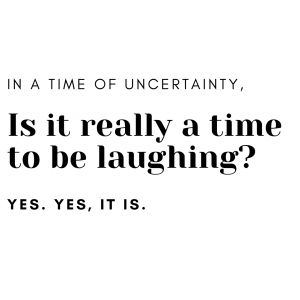What does humour have to do with leadership?
I came across this timely article by Stanford co-authors Jennifer Aaker and Naomi Bagdonas – How to be funny at work. Reference to this article made me laugh and reflect on my own humour style. Taking this into consideration, I once shared a joke with a colleague and encouraged them to do the same. It hardly managed to get any traction except for some isolated laughter about my jokes (I had them quickly scribbled down after catching on to it from a source). My guess, either the punchline didn’t have the intended outcome, or my colleagues are not the type to say “I love comedy shows; stand-up comedy; or I don’t get inuendos”.
Or perhaps, it was the bad delivery on my part. Humour aside, while leadership is often seen as a serious matter, it’s equally important to lead with a human touch.
This article, in particular, resonates with me because of its timely nature – Uncertainty.

It’s important to have high empathy towards others and the ability to listen. Human skills, coupled with learned skills make for a strong leadership trait. If leaders can be aptly funny, depending on the situation, these traits will favour not only their leadership but also their mental health.
After all, “common sense and a sense of humour are the same things, moving at different speeds. A sense of humour is just common sense, dancing.” – Clive James, Australian Author
Outlook in life as a leader.
During times of high stress and constant social expectation of perfection, having a laugh at ourselves can be surprisingly therapeutic. Because at the end of the day “laughter helps cure negative feelings”. Being a leader means that we can let loose, cut away the chip on our shoulder and wear our boots and get into the field; by having a sense of humour and being funny are plus points.
We also need to recognise that not everyone is born a class clown. Just like how leadership can be a learned trait, so is being funny. Many of us have developed a sense of humour with our colleagues from working with them, understanding their point of view, and getting to know them better. This brings us to the next step;
Identifying your personal humour type and those around you.
There are quite a few distinct types but here are four of the most common humour types as identified by Aaker and Bagdonas.

Edgy, sarcastic, nuanced – masters of the unexpected dig ~ Michelle Wolf. Image courtesy of EW.

Bold, irreverent and unafraid to ruffle a few feathers for a good laugh ~ Wanda Sykes. Image courtesy of Forbes.

Earnest, understated and use of humour to lighten the mood ~ 3 – James Corden. Image Courtesy of Vulture (CBS).

Expressive, charismatic and easy to make others laugh ~ Jimmy Fallon. Image courtesy of The NY Times.
While these comical men and women are celebrated in the entertainment industry, it’s important to draw inspiration from a variety of sources.
As for myself, I’m still exploring my humour style. I think I’m leaning more towards the ‘Sniper’ style, but I’m also taking a survey among my friends and colleagues. Perhaps you should too?
My approach has always been metaphorical, using analogies and stories to get my point across. While this has faced a number of quizzical expressions and furrowed brows, most of my metaphors have been received with laughter. Very few can create laughter and be funny at will. They are not professional comedians, it’s just their nature. This small group seem to have the gift of making others laugh! We may not be able to emulate or come close to it, but surely, we can pick up some moot points and apply them. I will learn to fine-tune my approaches while picking up some skills as well.
So, what do you think of humour? Is it a far-reaching trait that would sky-rocket you towards greatness; or is being unfunny a human weakness?
_______________________________________________________________________________
Kadam Balan is a thought leader who consistently works to contribute to the industry and community at large as a mindful global citizen. He spearheads the business division at SynergenOG, and other organisations.

